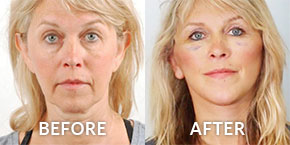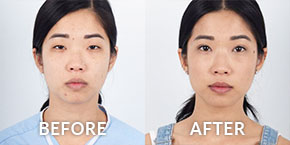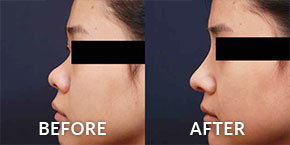Philosophy
There are four interconnected pillars that comprise my life. The first pillar is truth; the second, goodness; the third, love; and the fourth, beauty.
I recognized a correlation between these four factors before I began my career, and aspired to work towards beauty. I found that beauty yields the purest, most genuine form of joy to humans. Whether it may be manifested in music or paintings, humans appreciate it and thus surround themselves with things they consider beautiful. Furthermore, I found that the highest form of beauty exists within humans themselves. This is because unlike other things that we consider beautiful, such as sculptures or landscapes, humans exhibit two forms of beauty rather than just one; they possess both an inner beauty and an outer beauty. Thus came my ultimate pursuit in life; to help my patients achieve true radiance by enabling them to find their individual outer beauty, to match their inner beauty.
When I chose aesthetic surgery as my life’s practice, I wanted to help change the lives of those who come to see me. I wanted to see through their exterior, and find light, determination and love in their heart. I was compelled to create harmony between their exterior and interior. This inspired me to specifically choose Asian aesthetic surgery.
A Focus On Asian Aesthetics
Asian aesthetic surgery differs from the standard, mainly because Asians, especially East Asians, maintain different tissue structures and aesthetic sensibilities.
It is what I consider aesthetic surgery in its truest form. It requires the deepest understanding of science and engineering within the human body and its functions; knowledge of advanced surgical technique; as well as full commitment and aesthetic sensibility on the surgeon’s part. Unlike other types of surgery, it demands a tremendous amount of art, and a surgeon with a strong desire to help patients who want progress in their lives. I love to help people who give their most and try their best in order to attain progress in their lives. This is mainly because I sincerely identify with my patients who have a passion for life, and I feel compelled to aid them in reaching their aspirations.
Continuous Educational Pursuit
I combined my deep desire to help people with my appreciation for beauty, and thus recognized the significance of a continuous educational pursuit. Because of the extensive knowledge needed for the field, I underwent extensive schooling and educational research to learn the processes of tissue healing and regeneration; biological engineering concepts on augmentation and creation of new folds and contours on the human body; as well as minimally invasive surgical technique. I spent a year at the Howard Hughes Medical Institute at Yale University, studying how the tension in tissue affects surgical healing and tissue regeneration at molecular and cellular levels. I also committed one year in Switzerland to learn about minimally invasive surgical technique and its instrumentation development.
I continue to educate myself and conduct research on the latest surgical advancements, because I believe that my patients deserve the highest level of care. I have been researching and collaborating with renowned aesthetic surgeons in Korea for over ten years now, developing advanced surgical technique in the field. My Korean heritage enables me to communicate with the leading specialists in Asian aesthetic surgery, and have an intuition for which features truly complement Asian patients.
Before, I discussed my four pillars on life. They are important to me, as they shelter and stand for what is even more important to me: my patients. I became a doctor because I wanted to help people, and I became a plastic surgeon because I wanted to express my admiration for beauty, compassion, and the pursuit of perfection. As such, I have the upmost commitment to those who seek my help, and truly cherish the relationships that I form with them. What the patients need and want are of supreme importance to me, as I am most interested in helping them enjoy their lives with the beauty that touches their hearts most.
Becoming Who You Really Are
Regardless of race, ethnicity, age or gender, everyone has the natural desire to express their inner being in an outward manner. This is adapted through certain media, such as clothing, shoes, hair and makeup. Many use such media as a way to express their own perception of themselves on the inside. In a similar way, some choose to use plastic surgery as another method of manifesting their inner selves. In such an aspect, those who choose surgery are not necessarily succumbing to a societal norm for beauty, but rather being honest in the way they present themselves. For example, one very common reason that many patients undergo surgery is aging.
Imagine an attractive woman in her twenties, one who turns heads wherever she goes. Now imagine the same woman, only in her late fifties. Her own perception of herself is still in her twenties, when she was physically youthful and beautiful. However, she now looks into her mirror and becomes saddened, as she finds deep crevices on her forehead, droopy eyelids, and sagging cheeks. Her self-image has already formed and solidified in her mind during her twenties. She is still young and spirited at heart, and feels that what she sees in the mirror in no way represents her youthful inner self.
What I have described above is what many patients experience before they come in for consultation. What they see does not match how they feel about themselves inside. The ultimate decision that the patient must make before undergoing surgery is whether she wants to boldly express who she truly is inside, or not. The patient has the choice to live with the natural features that hinder her sense of inner personality and self-confidence, or to change that aspect in order to better her life.
One very important aspect of this self-confidence is self-honesty. If a patient feels that she wants larger eyes or a refined nose, she is essentially being honest with herself by admitting that she seeks fulfillment by feeling beautiful. And there is absolutely nothing wrong with that, as it is within human nature to want to feel and appear attractive. Those who maintain this sense of self-honesty choose aesthetic surgery for the right reasons. Surgery should be about being honest with yourself in desiring confidence, beauty, and progress in your life. Those who correspond with such a belief seek and embrace harmony between their inner and outer beings.
Progress
Civilization has developed and continues to evolve through social progress, improving and advancing as a result of various factors, with one of the most influential factors being direct human action. In other words, as individuals evolve into a more optimal state of human functioning, it is by our actions that we advance and improve society as a whole. In order for this evolution to take place, however, we must first embark on our own personal journey toward happiness and fulfillment.
As babies, humans enter the world dependent solely on our caregivers to tend to our basic needs and happiness. As we mature, we gradually move away from our self-centered dependency and progress toward independence. And as we further develop a sense of well-being, we then begin to recognize the needs of others – especially those of children, the elderly and the disabled. It is at our most optimal state that we feel a sense of responsibility to care for and help those most in need. This notion is similar to children who in their naivete believe in fictional characters such as Santa Claus, a bounteous benefactor that brings joy and gifts to all. As adults, it is easy to become increasingly logical, jaded, and unimaginative–losing the ability to see beyond reality. But for adults evolving toward fulfillment, Santa Claus, fiction or not, still resides within. These individuals believe that if there is goodness to be done for the betterment of others, it is up to them. As such, they embrace the role of Santa Claus themselves, bestowing joy and goodwill for others in need.
How does this evolution come about? It begins with the pursuit of our own happiness. At the core, all human beings long for joy and happiness. Happiness can be multifaceted, but shares a close link to the pursuit and fulfillment of one’s dreams and aspirations. Whether our goal is to improve our country’s socioeconomic status or simply to seek the daily freedom to do the things we most enjoy, our life’s passion can take many forms. But the path to fulfilling our dream is unlikely to be an easy one. We will likely encounter difficulty, sometimes in the form of unforeseen obstacles or other times as a result our own perceived limitations.
Finding Our Truest Path
And as individuals, each with our own set of unique characteristics, we are predisposed toward the things that interest us and those areas where our talents can best be used. Therefore, our pursuit is likely to be one-of-a-kind, and we must often be the first to pave the way.
Despite all the barriers we face, we must take look at these challenges as motivators to push us even harder toward our goal. This journey takes a tremendous amount of self-determination and perseverance, as well as sacrifice of our time, wants, desires, and everyday comforts. And if we are not hungry enough, we will likely give up. However, for the dedicated few, the human psyche is stronger than we think. During those moments when we think we have reached our breaking point, we must not give up. We must transcend. To do this, we will need to discover and tap into our inner fire, which often lies deep within us, hidden from view. This fire comes from love, and provides the needed fuel when all else has been exhausted.
Love is the most powerful motivator. This feeling of love drives us to persevere when we can no longer do it on our own. It comes from deep within our hearts, because when we pursue things closest to us, our heart is set aflame. The power of love not only burns within us, but also radiates outward and energizes others. And others who see the value of our dream will feel compelled to reach out to help. This power of love not only gives us strength to propel us forward, but also shines a light on our path.
We will know an evolution has taken place within us when we learn to feel empathy for others. Our minds will be open to the notion that everyone shares in life’s great journey and that everyone goes through difficult times. We also begin see others not as separate from us, but as an extension of ourselves. And when we see other people struggle, we are reminded of our own pain during times of hardship. As such, we will naturally want to help others. In doing so, we are also healing ourselves and, in a sense, dealing with the memories of our own past. This is how our dream – a dream that began with our own desire for happiness — changes to encapsulate the happiness and well-being of those around us.
Clarity and Commitment
Clarity is the ability to see and process things from every dimension without obstruction. From the front, back, above, below, three dimensionally, cellularly, molecularly, genetically, structurally, mechanically, physiologically, aesthetically, and emotionally. To have clarity, the surgeon must have a deep understanding of all the above components. The surgeon’s mind must be in an optimal state of calm and focus, a state achieved by an absolute, all-consuming commitment to both his craft and patients. This commitment is rooted in the responsibility bestowed on the surgeon, which he solemnly embraces. By understanding and accepting this responsibility, the surgeon commits himself and his life to the mastery of his craft and the ultimate well-being of his patients. The surgeon not only masters the procedure, but continues to innovate and teach others in the field, often consumed by thoughts of surgery and his patients even when not performing surgery. It is only with this level of absolute commitment that the surgeon can truly see with clarity.











